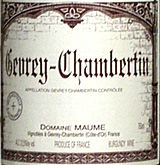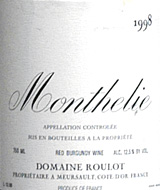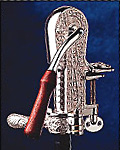|
Burgundy at a glance
One of the most severe limitations of the "30 Second" format - even when I press it well beyond that time span even for the most voracious speed-reader - is that it's tough to encompass some of the most important wine-related topics in the space of a short article intended for grab-and-go consumption. And so it is with Burgundy, one of the world's most historic wine regions and arguably one of its best. I've touched on Burgundy over the years with the occasional wine-tasting report or article focusing on a specific village or region, but to this point haven't tried to take on an overview. Burgundy is peculiarly difficult for the average wine enthusiast to get to know, not only because it's complicated but also because it tends to be expensive. Great Burgundy is rarely cheap, and cheap Burgundy isn't often great. Good buys are out there, but you have to work to find them. Since I'll be leading a tour of Burgundy (plus Champagne) with French Wine Explorers just over six months from now - and hope to persuade at least a few of you to come along (details below) - let's take a shot at a very basic summary today in a few short "bullet points" organized as a quick-reference card. • WHERE: Most broadly defined, Burgundy runs north and south along the Saone river in France between the cities of Lyons and Dijon (plus Chablis, which is a good distance northwest of all the rest). The southern portion of Burgundy incorporates the Chalonnaise, Maconnais and Beaujolais regions; but when most wine enthusiasts speak of Burgundy, they are talking about the relatively small section around Beaune, just south of Dijon, where the hillside stretch called Cote d'Or (Slope of Gold) incorporates the Cote de Nuits and the Cote de Beaune, where some of Earth's most favored vineyards grow. • WHAT: Called Bourgogne ("Boor-gon-yuh") in French, Burgundy wines are almost invariably made from only two grape varieties: Pinot Noir for the reds, and Chardonnay for the whites. There are a few exceptions, like the Gamay grape in Beaujolais and the white Aligote and Pinot Blanc. We'll talk about them another day. • WHEN: In terms of the length and texture of its vinous history, Burgundy is one for the books. Legend asserts that the ancient Romans found vineyards here when they conquered Gaul in 50 B.C., and vine growing has carried on without a break for more than 2,000 years since: by monks in the Dark Ages through Charlemagne's time, by dukes and barons thereafter, and by small farmers and entrepreneurs after the Revolution, when Napoleon's empire broke up the old holdings of the church and the nobility, a policy further complicated by inheritance to create a jigsaw-puzzle map of tiny properties that befuddles wine enthusiasts to this day. • WHY: What makes Burgundy so desirable? There is little debate that both Pinot Noir and Chardonnay reach their quality pinnacle in these relatively small places; and Pinot in particular, while one of the most challenging grapes to get right, is one of the most rewarding when it all works out. Two millennia of wine-making tradition and as much experience in selecting the best possible vineyard sites further contribute to the quality factor; and sheer rarity based on limited yields from tiny vineyards drives the supply-and-demand ratio for the most sought-after wines out of all proportion. Most of us will have little opportunity to taste the greatest Burgundies. But with a little effort and care, we can certainly enjoy some good ones.
ABOUT THAT BURGUNDY TOUR: We'll enjoy extensive tastings at top wine estates in Burgundy, including the best Premier and Grand Crus in the Cote de Beaune and the Cote de Nuits. Luxury accommodations are included at the elegant 4-star Hotel Le Cep in Beaune, and we'll dine in some of the region's best restaurants including the 3-star Lameloise in Chagny. In Champagne, we'll visit two of the world's most famous Champagne houses, Moet et Chandon and Veuve Clicquot, as well as top smaller producers. Our home in Champagne will be Relais & Chateau member 4-star Hotel Royal Champagne, with a commanding view over the vineyards of the Cote des Blancs. Along the way, we'll see some of the fascinating cultural sights in both regions, including the 13th century Clos de Vougeot and the spectacular Reims Cathedral, where the kings of France were crowned.
There's still room, but don't procrastinate, as the size of the tour group is strictly limited. A spot or two on this tour would make a great holiday-season present for a loved one, or yourself. For more information, or to make reservations, visit the Champagne and Burgundy tour page on the French Wine Explorers Website,
FOR MORE ADVANCED BURGUNDY INFO:
TALK ABOUT BURGUNDY ONLINE: If you prefer to comment privately, feel free to send me E-mail at wine@wineloverspage.com. I'm sorry that the overwhelming amount of mail I receive makes it tough to respond personally every time, but I do try to get back to as many as I can. And now, here are my tasting notes on two 1998 Burgundies of interest: A surprisingly good red for $10 from the appellation Monthelie, an underrated appellation in the Cote de Beaune; and a stylish, ageworthy village wine from Gevrey-Chambertin, a well-regarded region in the Cote de Nuits.  Domaine Maume 1998 Gevrey-Chambertin ($24.99)
Domaine Maume 1998 Gevrey-Chambertin ($24.99)
Clear ruby, not overly dark in color. Appetizing cherry aromas with a pleasant earthiness, well short of "barnyard," to add complexity in the nose. Ripe and juicy fruit flavors, tart and fresh, over a balanced structure of crisp acidity and slightly bitter tannins. Seems to close down in the glass after an hour or two, suggesting that it's still well short of mature. An unusually elegant Burgundy at a price that's toward the low end for the genre. U.S. importer: Kermit Lynch Wine Merchant, Berkeley, Calif. (Nov. 9, 2003) FOOD MATCH: Burgundies work well with beef and sing with salmon, but one of my favorite matches is wild mushrooms. This one worked very well with a simple dish of penne with porcini and white mushrooms in a light ricotta sauce. VALUE: Good Burgundies aren't cheap, but as noted, this one's style and approachability make it more than competitive in the mid-$20s. WHEN TO DRINK: Tannins and balance (and Maume's reputation) suggest aging potential. I would not hesitate to cellar this one.
WEB LINK: Smaller Burgundy producers in general seem slow to embrace the Internet, and I was unable to find a Website for Domaine Maume. However, there's a pleasant short report, with photos, by a German consumer (in English) at  Domaine Roulot 1998 Monthelie ($9.99)
Domaine Roulot 1998 Monthelie ($9.99)
Clear ruby color. Perfumed brown-spice aromas, appetizing but frankly more focused on spice than fruit; opens up very gradually with swirling and time in the glass. Simple, fresh red-fruit flavors, more open on the palate than the nose, clean if a bit light and short at first. After an hour in the glass, it opens up to good dried-cherry fruit and perceptible dry tannins, hinting at some potential for aging. U.S. importer: Kermit Lynch Wine Merchant, Berkeley, Calif. (Nov. 9, 2003) FOOD MATCH: Fine with wild-mushroom pasta, showing Burgundy's affinity for mushrooms. VALUE: An ageworthy Burgundy for $10? A no-brainer. WHEN TO DRINK: As noted, it's a bit closed and light now. At this price, it would be worth stashing away a few bottles for a year or two just to see how they develop.
WEB LINK: The producer has a Web address, but at this time it bears only an "under construction" note (in English). 
California Wine Club
Visit While you're visiting The California Wine Club's website, check out their special pricing on holiday gifts of 3, 6, 9 and 12 months. They make holiday shopping easy with no billing and no shipping until December 2003. Plus if you order your holiday gifts early and mention The 30 Second Wine Advisor they'll send you a copy of the Wine Fundamentals DVD, for FREE!
For more information visit 
Brentwood Wine Co. Why in the world would you want to sell your treasured wine? We can think of a few good reasons: The market has changed, and so have you. You bought too much wine back then; you need cash now. Or your tastes have changed, and it's time to take your gains on the varieties you bought in 1993 so you can buy what you like now. Whatever your reasons for taking wine to auction, Brentwood is the place for you. Here's why: • Brentwood pays sooner! With consignment auction houses, you'll wait months for your money. Brentwood pays in three to five days. • Brentwood pays more! You can count on average auction net or above for your wines. • Brentwood buys your wine outright! There's no risk of a bad auction result or unsold lots. • Free appraisals! Send your list to appraisal@brentwoodwine.com or fax it to 1-503-638-6737.
Of course selling is only half the game. If you're buying collectibles, Brentwood is your source for centerpiece wines for holiday entertaining. Enjoy the fun and excitement of buying wine at auction ... at Brentwood Wine Co., PS: Don't forget to check Brentwood for great buys on Riedel crystal wine glassware for the holidays: they've got some of the lowest prices on the planet! Sponsorship Opportunities There is no quicker, better or more efficient way to deliver a wine-related message to wine lovers around the world than WineLoversPage.com. Because we're not encumbered by the costs of producing a print publication or television program, our operating costs are relatively low, and this benefits our advertising partners in the form of rates that the traditional media can't deliver. And because we've been around the Web longer and enjoy wider readership than any other online wine publication, it's no surprise that advertising partners who've tried the competition tell us that the results - even from the big names in the wine-magazine world - simply don't compare. If you're in a position to give advertising a try, or if you know someone who might, I'll be happy to provide more information. Just drop me a note at wine@wineloverspage.com. This week on WineLoversPage.com Here are links to some of our recently published articles and features that I hope you'll enjoy:
• Nat Decants: Label Gazing
• April on wine: Party On! Last Week's Wine Advisor Index The Wine Advisor's daily edition is usually distributed on Mondays, Wednesdays and Fridays (and, for those who subscribe, the FoodLetter on Thursdays). Here's the index to last week's columns: • 13 "affordable" wines (Nov. 7, 2003) http://www.wineloverspage.com/wineadvisor1/tswa031107.phtml • Re-evaluating Kendall-Jackson (Nov. 5, 2003) http://www.wineloverspage.com/wineadvisor1/tswa031105.phtml • "Breathing" revisited (Nov. 3, 2003) http://www.wineloverspage.com/wineadvisor1/tswa031103.phtml
• Complete 30 Second Wine Advisor archive:
• Wine Advisor FoodLetter: Thai laab salad (Nov. 6, 2003)
• Wine Advisor Foodletter archive: Administrivia To subscribe or unsubscribe from The 30 Second Wine Advisor, change your E-mail address, or for any other administrative matters, please use the individualized hotlink found at the end of your E-mail edition. If this is not practical, contact me by E-mail at wine@wineloverspage.com, including the exact E-mail address that you used when you subscribed, so I can find your record. We do not use our E-mail list for any other purpose and will never give or sell your name or E-mail address to anyone. I welcome feedback, suggestions, and ideas for future columns. To contact me, please send E-mail to wine@wineloverspage.com All the wine-tasting reports posted here are consumer-oriented. In order to maintain objectivity and avoid conflicts of interest, I purchase all the wines I rate at my own expense in retail stores and accept no samples, gifts or other gratuities from the wine industry.
Monday, Nov. 10, 2003 |





